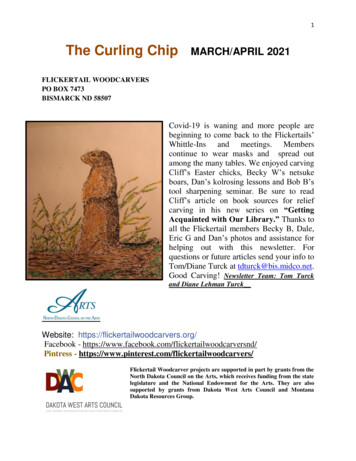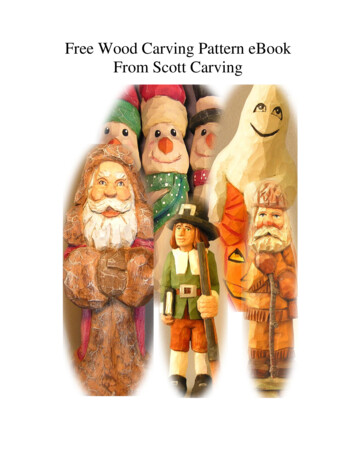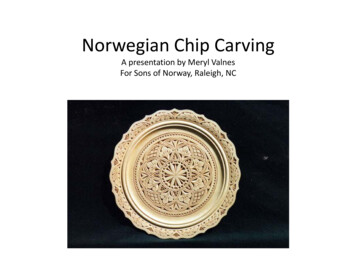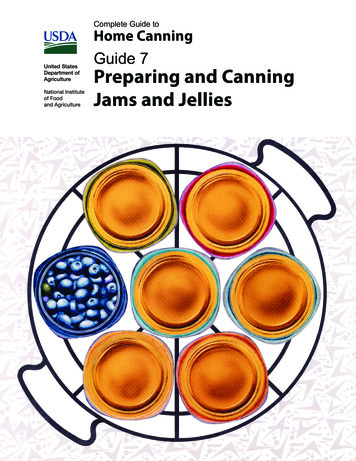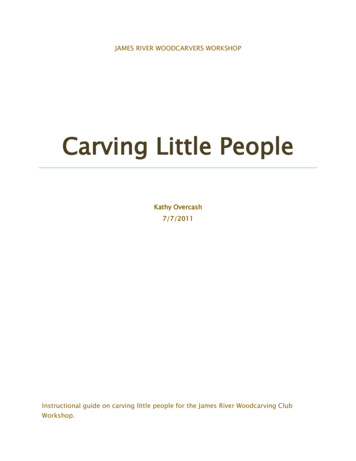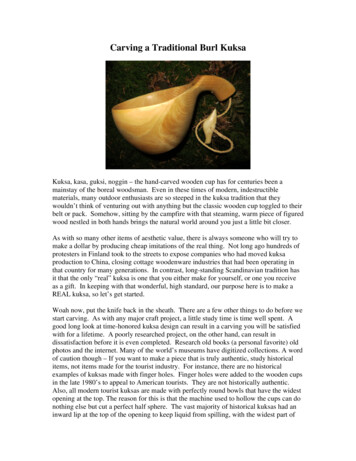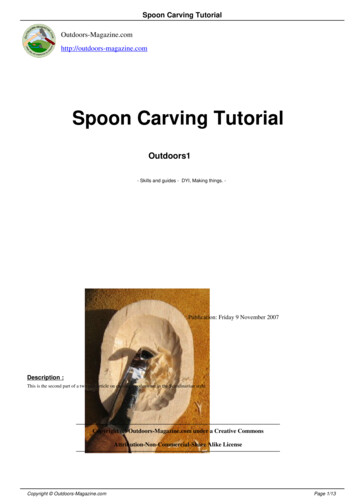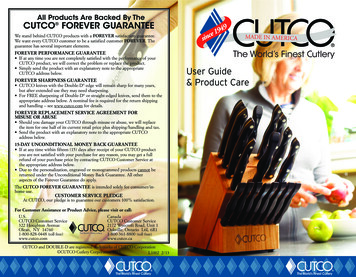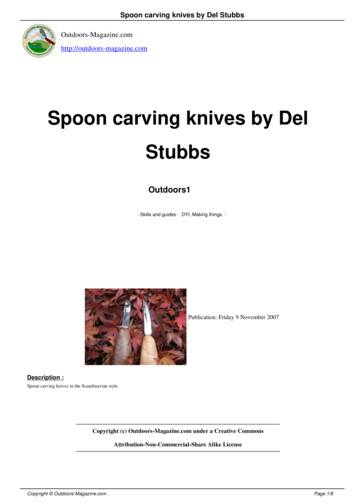
Transcription
Spoon carving knives by Del e.comSpoon carving knives by DelStubbsOutdoors1- Skills and guides - DYI, Making things. -Publication: Friday 9 November 2007Description :Spoon carving knives in the Scandinavian styleCopyright (c) Outdoors-Magazine.com under a Creative CommonsAttribution-Non-Commercial-Share Alike LicenseCopyright Outdoors-Magazine.comPage 1/8
Spoon carving knives by Del StubbsThis article provides a review of the spoon carving tool used in my earlier article (Here).Although other tools are used to carve spoons and ladles in the Scandinavian style, there are two that are essential.The first is a sharp, straight bladed knife to whittle the spoon to shape, and the second is a curved knife (called ahook knife or spoon knife), used to carve the hollow bowl of the spoon.Straight knivesIn the past, the knife was a very common tool in Scandinavian countries. Nearly everyone had one for work or foodpreparation. As a result, knives were readily available for woodworking (Sundquist, 1990).Scandinavian knives are currently available in a blizzard of sizes, styles, and materials covering virtually any pricerange. The design can be simple or ornate. Blades can be found in virtually any desired construction - carbon steelor stainless, single material or laminated. My preference for tool blades is carbon steel, but the Scandinavianstainless steels are also excellent.The importance of correct blade angle and bevelSundquist places a high value on having an appropriate edge angle on woodworking knives. He suggests that a flatbevel of approximately 25 degrees is ideal. The flat bevel allows you to use the entire bevel to support the cut. Ifthere is a secondary bevel on the knife, you have to turn the blade upwards to cut the wood, and the edge has verylittle support, making the cut less controllable.I have found that removing the secondary bevel and flattening and straightening the bevels as recommended inJimbo's excellent article (found here) is all that is necessary to prepare most Scandinavian knives for working greenwood.Handle ShapeThere are many knife handle designs: straight; tapered; dropped in the butt; swelled at the front, back, or both ends.For examples, handles with a dropped butt allow you to tell at a touch which way the blade edge is facing. I find thisto be an advantage for general outdoors use, but not necessarily for carving, where your eyes must be constantly onthe work.Copyright Outdoors-Magazine.comPage 2/8
Spoon carving knives by Del StubbsScandinavian straight knives Two knives from Frosts of Sweden (bottom) and one from Ericksson (top). I like thesmallest knife for carving spoons.For carving, I tend to agree with Sundquist's comments on tapered handles: Tapered handles, oval in section, areexcellent for carving. The thicker part of the handle fits well into the concave part of the hand, and gives the longermiddle finger a good grip on the knife. Because the handle is narrow close to the blade, it gives you the clearanceyou need to carve close to the blank. The taper towards both ends of the handle lets you get a better grip with bothyour index finger and your little finger. This safety feature helps to keep your hand from sliding off the butt of thehandle or slipping towards the blade. It is a traditional shape with soft and pleasant lines. (Wille Sundquist, 1990)."Although I have carving knives with more ergonomic handles, I nearly always find myself picking up the knives withsimple, tapered oval handles.Spoon KnivesScandinavians use a rather unusual knife for hollowing spoons - Sundquist calls them spoon knives. The blades arebent in varying profiles, so different spoon knives can be selected for spoons, cups, and bowls. Be sure to maintainthe original bevels when sharpening these knives, or you will be spending some time at the grindstone correcting theedges!Del Stubbs knivesA year or two ago, I was looking for a copy of Jogge Sundquist's video on carving Swedish woodenware. Del Stubbshad a few copies at the time, so I bought one (I believe the video is currently out of print). For those who are notfamiliar with Del Stubbs' work, he is a notable woodworker in his own right, and author of a video on woodturning(Bowl Turning with Del Stubbs).From time to time, I have returned to Del's site to look at his fine selection of tools, books and videos about Swedishcarving techniques. Del forges all of the tools himself, and the prices are extremely reasonable. You can purchasetools from Del either in a prepackaged set or individually. The spoon set consists of one of Del's handforged spoonknives (your choice of left or right handed), a handforged sloyd knife (1/ ¾ 4.3 mm or 2 ¼ or 5.5 mm), and fourspoon blanks. I purchased a set with the larger sloyd knife and a left handed spoon carving knife. Sets are alsoCopyright Outdoors-Magazine.comPage 3/8
Spoon carving knives by Del Stubbsavailable for the traditional art of kolrosing, a Scandinavian form of wood engraving. Historically, kolrosing was mostoften used to decorate spoons.Del Stubbs spoon knife and sloyd knifeYou can see from the photo above that Del pays great attention to all of the elements that make a fine tool - not justthe blade materials, but the crucial procedures of sharpening and polishing. The beauty of these tools is alsoapparent in the finely constructed handles.Del Stubbs Sloyd knifeFor me, the handle of a carving knife must have several basic attributes to be really useful. First it must provide asecure, non-slip grip. If the knife handle does not provide a secure grip, the carver will risk cutting themselves.Second, the handle must be usable in a variety of grips. Some handles are fine when carving away from yourself, butare not comfortable when the blade faces towards you.Del's knives satisfy both of these criteria. The handles are tapered ovals that have been finished with a matte finishthat provides a non-slip grip. The shape works well with a variety of grips and holds, and the smoothed surfaces donot create hot-spots that can become blisters. As you can see from the photos, the wood handles are also veryattractive.The shape of the Del's sloyd knife is typically Scandinavian - the top of the blade is straight, and most of the edge isflat, the last 1/3 or so curves up to the point. Overall the blade is 2 ¼ inches (5.5 cm). The edges are ground veryevenly in a traditional Scandinavian (or saber) grind. This type of edge not only supports the cut, but is easilymaintained.Copyright Outdoors-Magazine.comPage 4/8
Spoon carving knives by Del StubbsSloyd blade in profile The curved tip allows you to cut in tight places.Del has selected O-1 steel for these knives. This is a simple, high carbon steel that takes and holds a very fine edge I prefer this type of steel for most of my woodcarving tools.As you can see from the photographs, the fit and finish of Del's knife is exceptional. The wooden handle is smoothand well finished, and the blade has been polished to a mirror finish. The transition from the wooden handle to themetal blade is seamless and smooth. The knife is delivered with a razor edge, so you can get carving right away. Delincludes a flyer on how to maintain this fine edge.Stubbs sloyd knife - back of blade The back of this knife has been nicely rounded so you can grasp further up theblade while carving - a nice detail!Del also provides a sheath with this knife. The sheath is a made from birch bark in a traditional Scandinavian style similar to the ones shown in the books by Sundquist and Ljungberg. This sheath is attractive and provides protectionfor both the blade and the user.Copyright Outdoors-Magazine.comPage 5/8
Spoon carving knives by Del StubbsDel Stubbs straight knife and sheath Del includes a nicely made traditional birchbark sheath with these knivesSpoon knifeThis is how Del describes his spoon knives: These knives I completely hand make, from start to finish, and everypossible aspect of them I have thought through - from handle and blade shape, to the steel, and the temperingmethods. They, of course, have uses beyond spoon carving. The edges come perfectly sharp and the blades highlypolished - so that the knife glides through the wood, and so that sharpening is a breeze. The back of the blades arerounded and polished for comfort when pushing with a finger. I shape the handles from our 25 year collection ofbeautiful hardwoods. The steel: I have chosen L.J. Starrett '01' high carbon tool steel. It costs about twice whatnormal high carbon steel costs, it's the very best that I can buy. The hollow ground bevel (25 ) and the hardnessRC60-61 make these tools suitable for carving any wood from pine to maple.The handles of the Stubbs spoon knives are identical to those of the sloyd knives. As I have already noted, the finishresists slipping in the hand, and the oval shape is usable in a variety of grips. This is especially useful if you decide toget only one spoon knife. I find myself turning the blade of my knife in a variety of ways to carve the bowl of a spoon I also use this tool for tighter curves in the spoon handles.Copyright Outdoors-Magazine.comPage 6/8
Spoon carving knives by Del StubbsDel Stubbs left handed spoon knife back of bladeAs notes for Del's straight blades, the Stubbs spoon knives are made from high quality materials and finely hardened,tempered, and polished. The edge on mine was razor sharp, and the bevel was polished to a nice mirror finish.Since the bevel is cut onto the outside of the blade, you can cut a very tight curve with this tool. The back of thespoon knife is also rounded and polished, which allows you to use the opposite thumb to push the blade - this twohanded grip enhances both the amount of force you can apply to the cut and provides greater control.Dell Stubbs spoon knife, edge up The white spots on the edge are tiny basswood shavingsAs you can see on the photos, the overall fit and finish on these tools is excellent.Del also provides an innovative sheath for the spoon knife. The sheath is a block of foam with the shape of the bladecut into it. The blade fits in neatly (edge down) and an elastic cord holds the cloth cover over the back of the blade,securing it in place. This clever design uses modern materials in a simple but functional form that protects the bladeand the user.Copyright Outdoors-Magazine.comPage 7/8
Spoon carving knives by Del StubbsStubbs spoon knife with sheath This simple sheath provides good protection for the blade and carver.Conclusions:There is point where craftsmanship surpasses the simple execution of a design. This is the point where form andfunction merge, simplicity is transformed into elegance, and tool becomes art. Del Stubbs' work has clearly reachedthis point. His tools are not only elegantly functional, but have a beauty missing from many modern tools. Thesetools are a pleasure to behold, and truly a joy to use.WebsiteDell StubbsIn addition to his catalog of fine tools, Del's website lots of great information on Scandinavian spoon carving. Thereare webpages showing some fine example spoons, spoon carving techniques, carving grips, how to select a naturalcrook for spoon carving, and even one on making your own birchbark knife sheath. Del is planning on adding somelinks to videos showing various carving techniques as well. There are also links to other pages showing spooncarving from other cultures. Del's dvd of wooden bowl turning is available from Amazon.com and fine woodworkingsuppliers.Copyright Outdoors-Magazine.comPage 8/8
Spoon carving knives by Del Stubbs available for the traditional art of kolrosing, a Scandinavian form of wood engraving. Historically, kolrosing was most often used to decorate spoons. Del Stubbs spoon knife and sloyd knife You can see from the photo above that Del pays great attentio
